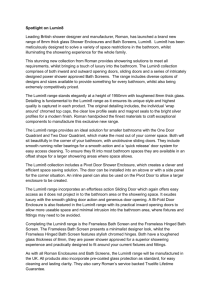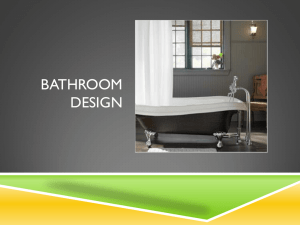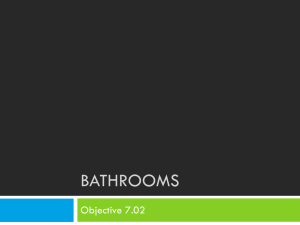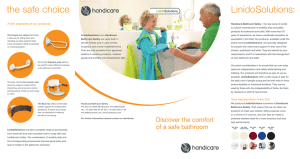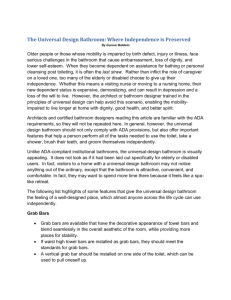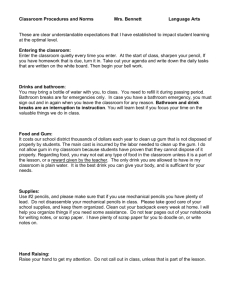Bathroom electrical safety document kit
advertisement
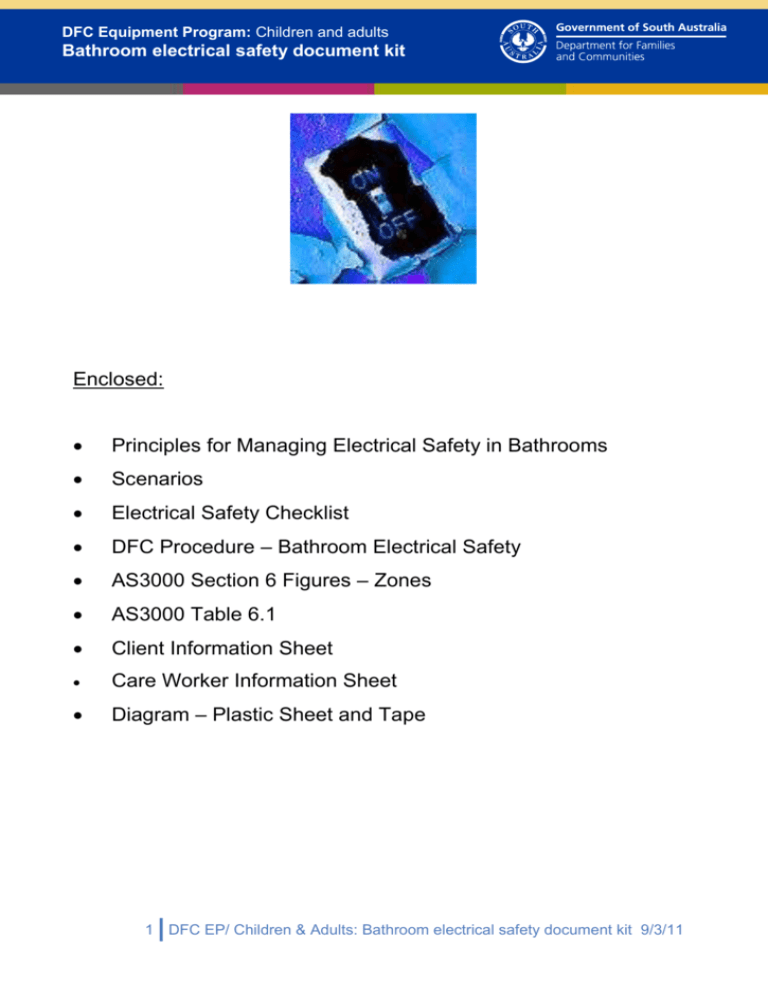
DFC Equipment Program: Children and adults Bathroom electrical safety document kit Enclosed: Principles for Managing Electrical Safety in Bathrooms Scenarios Electrical Safety Checklist DFC Procedure – Bathroom Electrical Safety AS3000 Section 6 Figures – Zones AS3000 Table 6.1 Client Information Sheet Care Worker Information Sheet Diagram – Plastic Sheet and Tape 1 DFC EP/ Children & Adults: Bathroom electrical safety document kit 9/3/11 Principles for Managing Electrical Safety in Bathrooms Use the Zones of AS3000 to define the areas of risk of water spray/splash within bathrooms. Clinical staff do not need to ensure that bathrooms comply with AS3000, but should use the dimensions of zones for guiding clinical reasoning around managing risk. Many homes were built before the current regulations were in place. The important principle for managing bathroom electrical risk is to prevent the entry of water into switches/sockets/devices. Acknowledgements The Department for Families and Communities (DFC) is grateful for the information and advice provided by the Office of the Technical Regulator. Department for Energy, Transport and Infrastructure (Government of South Australia) Use shower alcove or bath Whenever possible, showering should occur inside a shower alcove or over a bath. This practice makes best use of existing facilities (barriers, waterproofing, drainage) and minimises electrical risk. Temporary versus permanent changes to bathrooms When showering over a floor drain, temporary measures (such as covering with plastic) are acceptable in managing risk. The unorthodox use of the bathroom will, generally, be limited to people who have been instructed on how to work safely (client/carer/care attendants). It is unlikely that a visitor to the home will decide to take a shower in the middle of the floor when a regular shower is also available. For permanent changes to bathrooms (e.g. removal of fixed screens), more permanent measures should be considered to decrease risk (e.g. disconnecting power outlet or installation of waterproof switch). When permanent changes are made to the bathroom, there is the possibility that people unfamiliar with the environment may not take necessary precautions (e.g. a visiting family member using the shower may not be aware that switches or outlets need to be covered). Control water spray Use barriers where available. Water pressure should be low. Direct spray away from switches/sockets/devices. Use alcove or bath wherever possible. Showering a client outside of a designated shower alcove should be a last resort and requires a careful analysis of the electrical risks within the bathroom. Care worker to maintain control of hose when client not able. “Plug-on” style rubber hoses should be clamped onto tap outlet during use and covered with a hand towel to control spray in the event of a “blow-off”. Barriers Use or install barriers. Barriers should be closed as far as is practical. The removal of a barrier will result in changes to the dimensions of electrical zones. Avoid removing fixed barriers unless absolutely necessary. Zones Use the AS3000 zone dimensions to determine the degree of electrical risk in bathrooms. Areas of concern are Zones 1 and 2. 2 DFC EP/ Children & Adults: Bathroom electrical safety document kit 9/3/11 Principles for Managing Electrical Safety in Bathrooms Measurements need to be taken of distances to switches/sockets/devices from location on showering: 3 DFC EP/ Children & Adults: Bathroom electrical safety document kit 9/3/11 Principles for Managing Electrical Safety in Bathrooms Fixed plumbing outlet (FPO) inside a shower alcove or bath. Location of client when showering over floor drain in middle of bathroom. Physical changes to the bathroom (removing barriers) and the different use of the bathroom space (showering over a floor drain) may result in changes to the dimensions of the zones. Switches/sockets/devices Any switches/sockets/devices located within zones 1 and 2 need to be either protected against the entry of water or modified by an electrician. Outlets identified as being “at risk” should have a label fixed adjacent reading “Cover Before Showering” as a prompt to clients, carers and staff. Lights such as “batten holders” can be covered with a clip on cover. Effective seal/barrier The Office of the Technical Regulator recommends using a waterproof plastic sheet to cover outlets can be a method of preventing water from entering switches/sockets/devices. An effective seal is a protective cover that prevents the entry of water: Directly through the front of the outlet (or) Running down the wall to enter through the back of the outlet There are no guidelines on what can be used to make a seal, the dimensions or method of attaching it to a wall. DFC clinical staff have devised a size and method that takes into account the ease of application to the wall. An effective seal can be: A sheet of sturdy flexible plastic (approximately 600x600mm) Socket located behind the centre of the sheet Hung from the wall Taped seal along top edge of sheet A “seal” does not mean that all sides need to be taped. It is the dimension of the sheet that prevents the accidental entry of water. If a smaller sheet of plastic is used, tape around all of the edges needs to prevent the entry of water between the wall surface and the plastic sheet. It can be difficult to maintain an effective seal if taping over grout between tiles. Childproof covers, glad wrap or margarine containers are not effective covers. Condensation Strategies should be used to prevent excessive steam in bathrooms and build up of condensation on walls. Of particular concern are droplets of water running down the wall and behind switches/ sockets/devices. Use exhaust fans, open windows or doors. Other appliances Hairdryers, shavers, etc should be located outside of the room or in a cupboard to prevent them from being sprayed with water. Floor heaters can be used to heat a room but must be moved outside the bathroom prior to showering. Water Spray over Floor Is primarily a risk of slips and falls. Barriers should be installed and used. Non-slip mats should be used, or non-slip floor treatment. Care worker to dry floor following shower. 4 DFC EP/ Children & Adults: Bathroom electrical safety document kit 9/3/11 Principles for Managing Electrical Safety in Bathrooms Client Information Clients should be provided with verbal and written information on appropriate use of showerhose and electrical safety. Documentation The following areas require risk analysis and statements about how electrical safety risks are to be managed in bathrooms: Home modification prescription Shower-hose and removal of shower screen. Equipment prescription Rubber plug-on shower hose. Client file Progress notes should contain a record of clinical reasoning in relation to electrical safety issues for 1) Home modifications or 2) Implementing a personal care service. Use the “Electrical Safety Checklist” to guide clinical reasoning. Staff information and Service plans Care workers should be provided with written information on appropriate use of shower-hose and electrical safety. Hazard form (for personal care services) should include a statement such as: “Bathroom electrical safety issues exist in this house. Refer to service plan for specific instructions”. Service plans should give instructions on specific safety measures that are required for individual clients (only list specific issues that are not included in the information sheet) – e.g. “Use the plastic sheet provided to cover the power outlet located beside the hand basin”. Training Orientation for new clinical staff should include introduction to the Principles for Managing Electrical Safety in Bathrooms by an approved prescriber for hand showers and removal of barriers who has completed the Bathroom Electrical Safety training. Clinicians are required to complete the item specific approved prescriber process prior to prescription of these items/modifications. Staff should complete the Bathroom Electrical Safety training as soon as able. Staff who have completed training are encouraged to seek clarification from on-site clinical resource people for more complex issues. 5 DFC EP/ Children & Adults: Bathroom electrical safety document kit 9/3/11 Scenarios Five scenarios have been developed to assist occupational therapists with clinical reasoning using AS3000 Electrical Installations – Domestic Installations (Amendment 3 Section 7.1 Locations containing baths, showers or other fixed water containers) as a guide. The aim of these scenarios is to analyse risk around common bathroom situations: electrical safety, client function, prescribing equipment/home modifications and the provision of in-home assistance. Acknowledgements Department for Families and Communities is grateful for the information and advice provided by the Office of the Technical Regulator. Department for Energy, Transport and Infrastructure (Government of South Australia). Scenario 1 Client showering in an enclosed alcove independently with door shut. Scenario 2 Client showering in an enclosed alcove assisted by carer or care attendant with door partly open. Scenario 3 Removal of a glass shower alcove door for mobile shower chair access. Assisted by carer. Scenario 4 Showering on a bathboard. Scenario 5 Showering on mobile shower chair positioned over floor drain. 6 DFC EP/ Children & Adults: Bathroom electrical safety document kit 9/3/11 Scenarios Scenario 1 Client showering independently seated on a shower chair in shower alcove. Hand-held shower hose is to be installed. What issues need to be considered and what recommendations need to be made? Solutions Note the location and distance to Power Point, light switch. Determine the dimensions of the Zones. Advise client to keep door closed during showering. The light switch and power socket in this example fall in Zone 3. No changes are required. Provide client/carer with written and verbal advice on the correct use of a hand-held shower hose. 7 DFC EP/ Children & Adults: Bathroom electrical safety document kit 9/3/11 Scenarios Scenario 2 Same bathroom as #2 Client showering seated on a shower chair in shower alcove assisted by a care worker. There is a hand-held shower hose in the alcove. What issues need to be considered and what recommendations need to be made? In particular, the care attendant assisting the client through a partly open door. Solutions Note the location and distance to Power Point, light switch. Determine the dimensions of the Zones. When a care worker is assisting, the door should be kept closed as far as possible. Measure zones extending through the “opening”. The care worker standing in the open shower door will act as a barrier minimising water splash. Consider slipping risk from water splash on the floor outside the shower. Worker/carer will need to check that the floor is dry before client exits shower. The bathroom is presented in the diagram below with the sliding door in the open position. The absence of a barrier (or in this case, not using the barrier) causes Zone 1 to extend the full 1.2m from the fixed plumbing outlet. Zone 2 extends a further 0.6m The power socket beside the basin is now in Zone 2. The power socket should be covered with a plastic sheet during showering. Provide client/carer with written and verbal advice on the correct use of a hand-held shower hose. Document safe procedure in service plan. 8 DFC EP/ Children & Adults: Bathroom electrical safety document kit 9/3/11 Scenarios Scenario 3 Client has limited mobility and is showered seated on a mobile shower chair. The client is assisted by a care worker. Glass sliding doors and fixed panels are removed to improve access to the alcove. There is a power socket 450mm from the fixed panel of the sliding door. Explain what you would do in this situation to address safety issues. Near wall Distant wall Solutions Note the location and distance to power socket, light switch. Determine the dimensions of the Zones. The removal of the glass sliding barrier should be replaced with a shower curtain. With a shower curtain in place: The power outlet should be disconnected. It may be relocated on the other side of the basin. No change to the light switch is required. If a curtain is not installed: The light switch should be waterproofed or relocated. If a care worker is assisting with the curtain partly open, the curtain should be opened from the “distant wall” opposite the fixed plumbing outlet (FPO) – decreasing expose of the socket to water splash/spray. Opening the curtain from the “near wall” closer to the fixed plumbing outlet exposes the light switch to water splash. The last ring of the shower curtain should be fixed to the wall closest to the FPO. This is to prevent the curtain from being opened to expose the light switch to Zone 1. This should be documented clearly in the service plan. If the curtain will be fully open during showering, then a plastic sheet should be used to cover the light switch. Care should be taken that water splash has not made the bathroom floor slippery. The bathroom floor should be dried with a dry mop or towel after showering. Provide client/carer with written and verbal advice on the correct use of a hand-held shower hose. Document procedure in service plan. 9 DFC EP/ Children & Adults: Bathroom electrical safety document kit 9/3/11 n Scenarios Scenario 4 Client showering independently seated on a bathboard, using a shower hose attached to the shower fixed plumbing outlet. Without a curtain in place. There is a power socket and a light switch in the room. Explain what you would do in this situation to address safety issues. Consider the effect of a shower curtain in this situation. Solutions Arrange for the installation of a shower curtain. Without a curtain the power point in the bathroom falls into Zone 2 and must be disconnected. With a curtain in place and drawn across during showering, the power point is in Zone 3 and can remain unchanged. Even with a curtain partly drawn (open from the far wall), the spray of water is contained. The light switch is in Zone 3 (with or without the curtain). Monitor splash on the floor. Care should be taken when the client is stepping out of the bath that water plash has not made the bathroom floor slippery. Ensure that the bathroom floor is dried with a dry mop or towel after showering. Provide client/carer with written and verbal advice on the correct use of a hand-held shower hose. It is advisable to fix the end curtain ring adjacent the wall to prevent the curtain from being opened from the “near wall” to the shower hose. 10 DFC EP/ Children & Adults: Bathroom electrical safety document kit 9/3/11 Scenarios Scenario 5 Client with limited mobility showers seated on a mobile shower chair. There is limited space in the bathroom (shower over bath). The only option is for client to be showered over floor drain. A push-on rubber hand-held shower hose used from basin. There is a power point and a light switch in the room. What are the safety measures you would need to take before starting this service? Solutions Showering a client over the floor drain completely changes the nature of the bathroom. This situation is not covered in the Standard. Power points and light switches would have been installed with allowance only for splash from the bath and splash from the basin. As this is a temporary change of use of the bathroom, temporary strategies may be used to decrease the risk. The light switch must be covered with a plastic sheet during showering. Waterproofing (IPX4) or relocating the light switch is optional. The power point must be covered with a plastic sheet during showering. Disconnecting the power point is optional. It is important to check that there is adequate drainage of water to the floor trap. Bathroom floors are not designed to be used for showering. The gradient of bathroom floors is more shallow than the gradient required inside an alcove. Ensure that the bathroom floor is dried with a dry mop or towel after showering. Consider non-slip mats or floor treatment. The standards do not refer to the scenario of a push-on hose used from a hand basin. For practical purposes, the measurement of the extent of Zone 1 should be taken from the middle of the bathroom floor where showering is to take place. Document procedure in service plan. Push-on hoses should be clamped around basin outlet to prevent “blowing off” under pressure. Covering the plug with a towel will contain spray in the event of a hose “blow off”. 11 DFC EP/ Children & Adults: Bathroom electrical safety document kit 9/3/11 Scenarios Scenario 5 (continued) Why is the power point so close to the hand basin? The Australian Standards 3018 Electrical Installations – Domestic, gives a dimension of Zone 2 surrounding a hand basin (fixed water container with capacity less than 45L). Basins are designed to contain a small volume of water with a downward flow into the drain. Attaching a rubber hose changes the nature of the plumbing fixture, and increases the likelihood of water spray into switches. An adjustable clamp may be needed to hold the hose on taps when in use. Basin Zones 12 DFC EP/ Children & Adults: Bathroom electrical safety document kit 9/3/11 Electrical Safety Check List The questions listed below should be used to guide clinical reasoning around bathroom modifications and provision of in-home services. The following documents should be used to guide decision making: AS3000 Amendment 3 – Electrical Installations DCSA Bathroom Electrical Safety Procedure Principles for Managing Electrical Safety in Bathrooms Identify: Identify: Identify: Identify: Outline: Communication: Switches/sockets/devices in bathroom Distance from Fixed Plumbing Outlet (FPO) & Zone Barriers currently in place/to be installed If barriers have been removed If showering is to take place over a floor drain If the removal of barriers or change in use of the bathroom has resulted in changes to the dimension of bathroom Zones? Are there now switches/sockets/devices located in Zone 1 or 2? Strategy to prevent water entering electrical outlets in Zones 1 and 2 How will this strategy be communicated to: Staff - documented in service plan Client/carer – written information 13 DFC EP/ Children & Adults: Bathroom electrical safety document kit 9/3/11 DFC Procedure – Bathroom Electrical Safety The Department for Families and Communities (DFC) is committed to providing equitable, inclusive and culturally appropriate services in an environment that has due regard to the health, safety and well being of clients, carers and staff. This procedure guides Domiciliary Care SA and Disability SA staff in the assessment for bathroom modifications or hand held showers that is required to assist with function and independence in the client’s home. Bathroom electrical safety will also need to be assessed for the provision of personal support services. This procedure has been based on the advice provided by the Office of the Technical Regulator (OTR), Department for Transport, Energy & Infrastructure, Government of South Australia and risk analysis performed by Domiciliary Care SA clinical staff. Although all new electrical work must comply with Statutory Regulations (AS3000), these standards apply to electricians performing electrical work. Clinical staff do not need to ensure that bathrooms comply with the standards. However, AS3000 should be used as a guide in the management of risk especially when planning home modifications and in-home personal care services. The important principle of bathroom electrical safety is preventing the entry of water into switches/sockets/devices. 1. Installation of hand held showers and removal of barriers in bathrooms are category 1 home modifications and provision of push-on shower hoses are category 1 equipment items. 2. Item specific approved prescriber status is required for prescription of hand held or push on showers and/or removal of barriers in a bathroom. Only Domiciliary Care SA or Disability SA staff who have completed the training course in Electrical Safety and Bathroom Design can prescribe. 3. Wherever possible, showering should occur in a bathroom in an alcove or over a bath. Where this is not possible, the alternative location is considered to be a washroom and electrical safety must be assessed. 4. The clinician must locate all switches, power sockets and luminaries in the bathroom/ washroom. 4.1. 5. When possible the clinician will ascertain from the client or carer if the house has a Residual Current Device fitted. The clinician will measure distances from the fixed water source to any switch, power socket or other fixed electrical devices in the bathroom/washroom and take into account existing barriers, either fixed or portable. 5.1. In the case where the alcove and/or bath can not be used for showering and the area becomes a washroom, then the clinician will measure the distance from the position at which the showering is taking place to any electrical fittings. 6. AS/NZS 3000 should be used as a guide to determine whether any additional risk management strategies need to be implemented in the particular bathroom/washroom situation. 7. When there are modifications or equipment requests requiring approved prescriber status but no apparent issues in ensuring electrical safety, the clinician will discuss their clinical reasoning with an approved prescriber for the items. 14 DFC EP/ Children & Adults: Bathroom electrical safety document kit 9/3/11 DFC Procedure – Bathroom Electrical Safety 8. When electrical safety issues are identified, the clinician will problem solve and make recommendations that may include the following risk management strategies: 8.1. Installing barriers including shower curtains and keeping them as closed as practicable, or use an effective seal/barrier. 8.2. Control water spray by keeping water pressure low. 8.3. Direct spray away from switches/sockets/devices. 8.4. Assistant (i.e. carer, paramedical aide, care worker, OT) to maintain control of hose when client not able or unreliable. 8.5. Use exhaust fans, open windows or doors to minimise steam/condensation. 9. Clients, carers and staff will be provided with information sheets to inform them of general bathroom electrical safety risks and safety recommendations. 10. Clients and carers can be given information regarding possible electrical modifications they may choose to make by engaging a private electrician. 11. When a clinician completes a review of a bathroom or personal care service they will follow the steps above to determine if the bathroom meets electrical safety guidelines. 12. If no safe alternative is identified by the approved prescriber, they should consult with site based Bathroom and Electrical Safety resource person or Team Manager, CSA Team Leader/Palliative Liaison Officer (PLO) to further investigate options. This may include consultation with the Office of the Technical Regulator. 13. In the exceptional circumstances where no safe alternative exists and it is identified that electrical modification to the bathroom/washroom need to occur prior to the commencement of showering services, proceed as follows following approval by the delegate (refer to Seeking delegate approval for home modifications). 13.1. Client and staff to use alternate safe method e.g. sponge in shower chair or avoid task prior to electrical work being undertaken. For Domiciliary Care SA, the service plan must be updated to reflect this. 13.2. If the client/carer is willing to undertake and fund the necessary electrical modifications, DFC will provide the necessary equipment/home modification and information to facilitate the client engaging an electrician. 13.3. If the client/carer is willing to undertake the necessary electrical modifications, but cost is a barrier, DFC will provide the necessary equipment/modification and the Service Coordinator will assist the client to achieve compliance: 13.3.1 Referring to external sources e.g. local council where this option exists. 13.3.2 Application for subsidised funding up to $500 via Domiciliary Care SA donations account or via Disability SA brokerage. 15 DFC EP/ Children & Adults: Bathroom electrical safety document kit 9/3/11 DFC Procedure – Bathroom Electrical Safety For Domiciliary Care SA only: Complete donations application form located on Intranet (F-DCSA/GA 5.05-1). Team Leader to endorse. Client Services Manager to approve up to $200. General Manager Client Services to approve up to $500. Service to be engaged by householder (consider Council list of ‘honest brokers’ or ‘Stay at Home Modifications Service’). Invoice from supplier for amounts not exceeding $500 to be made out to ‘Domiciliary Care SA’ attention General Manager Client Services (Norwood Office) for payment. 13.3.3 If quote for necessary works exceeds $500 and client unable to pay balance, request to be referred to General Manager Client Services for attention of Executive Director prior to work proceeding. 13.3.4 If no safe alternative exists and electrical compliance can be achieved but homeowner refuses to have this work undertaken whether costs are subsidized or not, the equipment/modification is not to be provided by DFC. Where this means that a personal support service cannot be safely delivered the client/carer need to be informed that this is the outcome of the homeowner’s decision. If the homeowner is Housing SA refer matter to Team Leader/Client Services Manager for follow up. 14. All recommendations must be clearly documented in service plans and clinical reasoning documented in progress notes. 16 DFC EP/ Children & Adults: Bathroom electrical safety document kit 9/3/11 AS3000 Section 6 Figures - Zones AS/NZS 3000 (2007) 17 DFC EP/ Children & Adults: Bathroom electrical safety document kit 9/3/11 AS3000 Section 6 Figures - Zones 18 DFC EP/ Children & Adults: Bathroom electrical safety document kit 9/3/11 AS3000 Table 6.1 19 DFC EP/ Children & Adults: Bathroom electrical safety document kit 9/3/11 Bathroom Electrical Safety Client Information The installation of a hand held shower hose has been recommended to increase your safety and comfort in the shower. In providing you with the hand held shower hose, it is important to remind you that the incorrect use of this equipment can result in injury. For example, electric shock from water spraying into power points, falls on wet floor surfaces, and scalding due to changes in water temperature The following are guidelines for safe use of your hand held shower hose. INSTRUCTIONS FOR USE Turning on the water Do not use the shower hose with full water pressure as it can be difficult to control the spray of water, and uncomfortable on fragile skin. Checking the temperature Monitor changes in temperature during the showering routine to avoid shock or scalding from sudden changes in water temperature. Direct the water away from the skin when you are adjusting the temperature. Barriers Shower doors and curtains are effective barriers against water spraying outside of the shower alcove and should be kept closed at all times. If someone is helping you with showering, the door or curtain should be closed as far as possible to limit water spray. Controlling the shower hose The shower hose should only be used inside the shower alcove or over the bath. It should not be used outside of these areas. Do not leave the shower-hose hanging and spinning during use. Place it in a wall mounted bracket to control the hose when you need to use both hands for washing. Keep the water spray directed into the shower alcove at all times. Slippery floors Be aware that water spray onto the bathroom floor through an open door may increase the risk of slipping. Use non-slip mats and bath mats on the floor to control the slip risk. If someone is helping you with showering, with a door or curtain slightly open, they should make sure the floor has been dried before you step out. Ventilation Avoid the build up of condensation in the bathroom during showering by keeping fans on, the door slightly ajar and keeping showers short. Electrical safety Ensure that water spray from the hose is directed away from electrical fittings at all times. Electrical devices such as blow heaters, heaters, hair dryers, should remain disconnected and either placed in a cupboard or taken out of the room or while showering. 20 DFC EP/ Children & Adults: Bathroom electrical safety document kit 9/3/11 Bathroom Electrical Safety Client Information It is advisable for all households to have an Residual Current Device (Electrical Safety Switch) installed for general electrical safety. Who can use your hand held shower hose? The hand held shower hose has been provided for your use. If another person (family or visitor) is going to use this equipment it is important that you explain the precautions and safety instructions. Keep this instruction sheet handy for future reference. Children and visitors with memory loss or dementia should be supervised when using the hand-held shower hose to make sure that safety recommendations are followed. Care and Maintenance Regularly check the hose for wear or damage. If the water flow becomes restricted the shower hose head can be removed for cleaning with an old toothbrush. If you have any concerns about the shower hose contact your Service Coordinator or Key Contact to arrange a review. For further information please contact your local Domiciliary Care SA / ASSIST office. 21 DFC EP/ Children & Adults: Bathroom electrical safety document kit 9/3/11 Bathroom Electrical Safety Care Worker Information An Occupational Therapist from Department for Families and Communities (DFC) has recommended the installation of a hand held shower hose to increase the safety and comfort of your client’s showering routine. The Occupational Therapist has assessed the client and their bathroom to determine the client’s level of independence in showering, the need for assistance, their ability to use a shower hose and other items of equipment provided and hazards in the bathroom including electrical hazards. It is important for you to remember some precautions when using the hand held shower hose to minimise safety risks that could occur when using this equipment. The following are guidelines for safe use of your hand held shower hose and should be used in conjunction with the service plan written by the Occupational Therapist. INSTRUCTIONS FOR USE Turning on the water Do not turn the tap to full pressure when there is a shower hose installed as the pressure can make the shower hose hard to hold and spin out of control. Do not leave it dangling and spinning while the water is running. Be aware full water pressure results in a stronger spray that can also be uncomfortable for the client. Checking the temperature Direct the water away from you and the client when you are adjusting the temperature. As the water temperature can fluctuate with hand held showers keep your finger in the flow of the water so you can check for temperature changes and move the spray away from your client immediately if necessary. Barriers Shower doors and curtains are effective barriers against spraying water which could present a hazard where electrical switches or appliances are in the bathroom. When assisting a client with showering, the door or curtain should be closed as far as possible to minimise splash. Barriers between the water spray zone and electrical outlets in the room may have been recommended and installed by the Occupational Therapist; always ensure you check the service plan. Controlling the shower hose The fixed hand held shower hose should only be used inside the shower alcove/or over the bath as prescribed by the Occupational Therapist and within the service plan guidelines. Make sure you maintain control of the hose at all times for both you and your client’s comfort and safety. When you need both hands free for periods to assist the client, use one of the wall mounted brackets to hold the shower head in place. Only let the client hold the hose if they can reliably do this. Do not leave it dangling. Ensure the water spray is never directed towards electrical fittings (power points, lights, light switches, heaters, etc). 22 DFC EP/ Children & Adults: Bathroom electrical safety document kit 9/3/11 Bathroom Electrical Safety Care Worker Information Slippery floors Be aware of water spray onto the bathroom floor, the risk of slipping is increased for you and your client. Where the use of non-slip mats is indicated on the care plan, ensure these are in place. Make sure the floor has been dried and is not wet and slippery when the client is transferring out of the shower. Electrical appliances Electrical appliance (e.g. blow heaters, washing machines and hair dryers) must be switched off, disconnected and not used in the bathroom whilst the shower is in use. Shower mountings The shower hose and wall bracket must not be used to pull up on as they are not a weight bearing fixture and may pull of the wall – consult with the Occupational Therapist if you think installation of a weight beating support rail may be necessary for your client. Client capacity precautions Clients with memory loss or dementia should be supervised when using a hand held shower hose. Ventilation and condensation Condensation needs to be kept to a minimum in a bathroom where electrical outlets exist; keep the door slightly ajar for good airflow and ensure exhaust fans are on during showering. Keep showers short to avoid condensation build up over time. Plastic barriers In some cases, a service plan will specify a plastic barrier is to be used to protect electrical switches, power points or lights. These must be installed using the recommended tape prior to commencing the shower routine according to the directions on the service plan. Rubber plug-on shower hose Use a clamp to decrease the risk of the hose “blowing-off” the basin/bath outlet due to water pressure. Cover the join between the hose and taps with a hand towel to prevent accidental water spray. Care and Maintenance Regularly check the components of the shower hose as they can wear, perish or rust over time. If the water flow becomes restricted or loses its fine spray, remove the screw in the shower head (if present) and clean the outlet with an old toothbrush. After use, drain the water out of the hose before hanging it up. Check any electrical power point in the room; if it has been covered with a shower curtain or a temporary cover of firm plastic held in place with waterproof tape check that the tape still has a complete and firm seal. If you have any concerns regarding bathroom electrical safety issues, please report these to the client’s Service Coordinator or Key Contact / ASSIST clinician. 23 DFC EP/ Children & Adults: Bathroom electrical safety document kit 9/3/11 Diagram - Plastic Sheet and Tape When clients are showered over a floor drain, additional precaution may be required to prevent water splash from entering power outlets, light switches and other electrical devices. The following are instructions for using the sheet and tape: A 600 x 600mm plastic sheet should be taped against the wall with the socket positioned under the centre of the sheet. A single line of tape across the top of the sheet is adequate. Blue (low adhesive) masking tape should be used on painted walls to decrease risk of paintwork being damaged. Take care when peeling off the tape. White (regular) masking tape should be used on tiled walls. The sheet should be removed following completion of the shower. Tape along top edge of sheet Plastic Sheet Cover Before Showering 600 mm 600 mm A notice reading “Cover Before Showering” should remain above the outlet as a reminder to use the sheet and tape. 24 DFC EP/ Children & Adults: Bathroom electrical safety document kit 9/3/11
